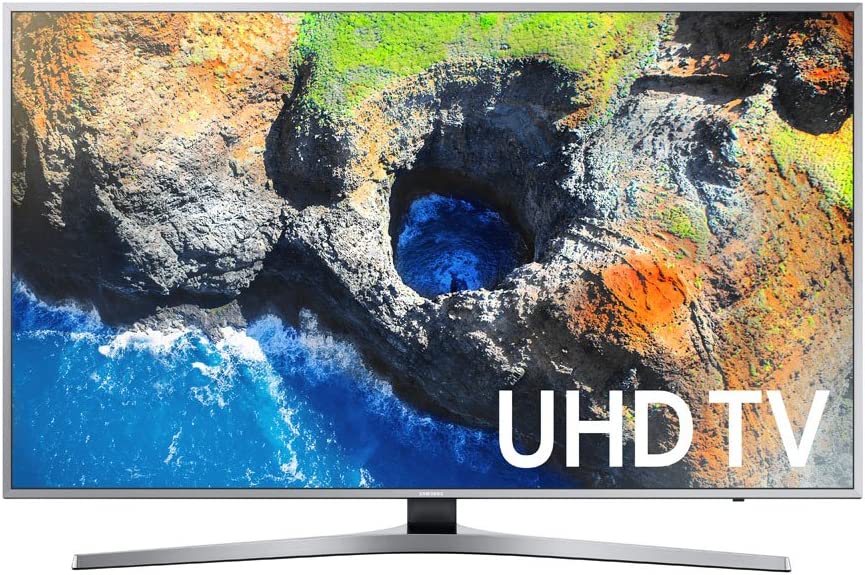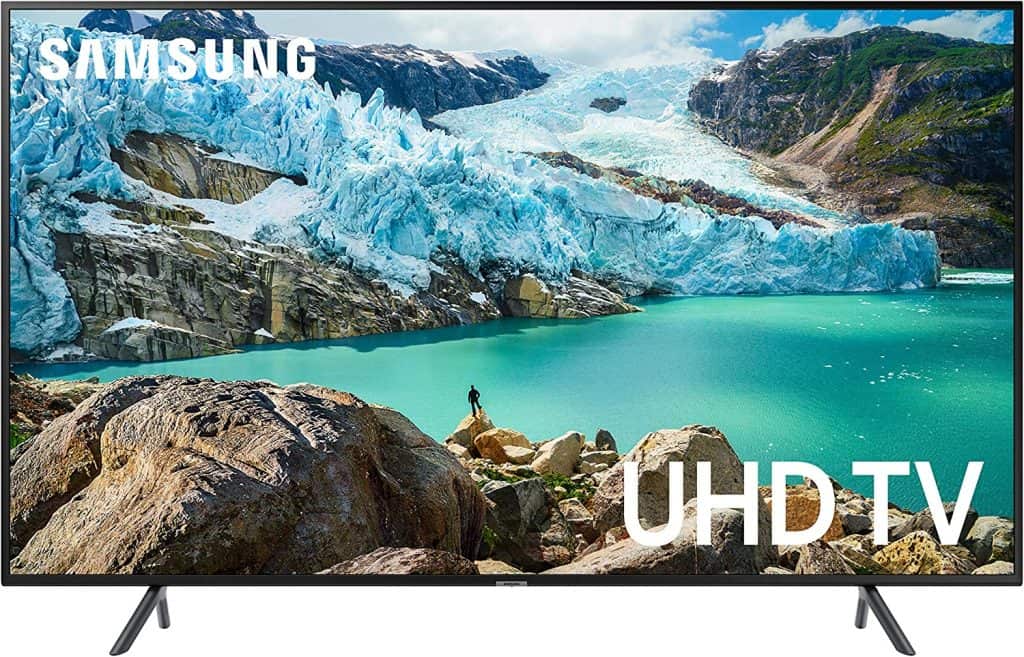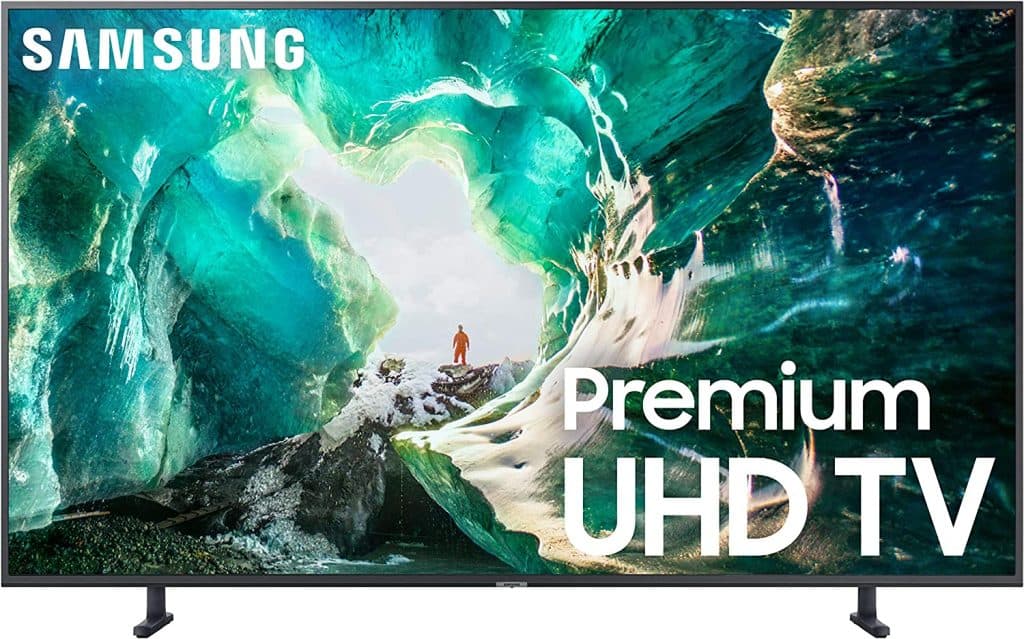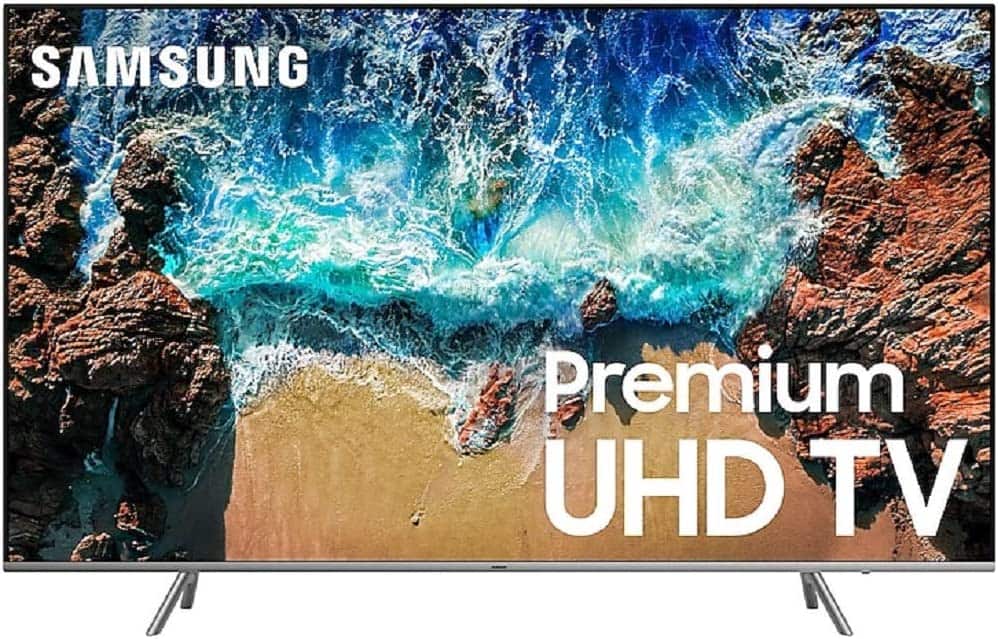Samsung is one of the most reputable TV manufacturers in the industry, and you can’t go wrong no matter which of their products you choose. That said, with so many options available when it comes to Samsung TVs, it can be challenging to decide, even when you narrow down your choices to just two product lines, the 7 Series and the 8 Series.
With that in mind, you need to pay attention to a lengthy list of critical factors when choosing a new TV. This detailed Samsung 7 Series vs 8 Series post will cover all of these essential aspects and help you pick the most suitable TV according to your needs and budget.
Samsung 7 Series vs 8 Series – Quick Comparison
Samsung 7 Series
With a very affordable price point for a Samsung TV, the 7 Series primarily appeals to those looking to buy a big brand TV set without breaking the bank. Still, it delivers solid quality on all levels and makes for a good TV for mixed usage. Here are the 7 Series’ biggest pros and cons:
Pros:
- Some models support HDR10+
- Reasonably priced
- Versatile and smooth Tizen OS
- Very low input lag
Cons:
- No Dolby Vision
- Lack of any advanced gaming features
Samsung 8 Series
The 8 Series lineup delivers sharp and detailed 4K pictures, a great smart platform, and superb motion handling capabilities. It’s designed to bridge the gap between the 7 Series line and the higher-end QLED models. Its most significant advantages and disadvantages include:
Pros:
- Some models support HDR10+
- A solid lineup of gaming features and settings
- Versatile and smooth Tizen OS
- Wonderful motion handling technology
Cons:
- No Dolby Vision
- Average audio quality
Samsung 7 Series
Price
Models from the 7 Series are pretty affordable, especially in the context of this comparison. With that in mind, if you’re shopping on a tight budget, 7 Series models are the better choice over 8 Series models.
Panel Technology
Samsung 7 Series TVs use LED VA panel technology. VA panels rank highly among other panel technology in terms of image depth and native contrast. That said, they also have slower response times and relatively disappointing viewing angles. VA panels are long-lasting and durable, meaning that they are excellent for regular mixed usage.
Image Processor
Samsung 7 Series TVs use a Crystal Processor 4K, a very capable new-gen processor with several advanced features. This image processor analyzes low-resolution videos and upscales the content to 4K-level quality through sophisticated color mapping, resolution adjustment, and contrast ratio optimization.
Motion Technology
7 Series TVs have a good response time suitable for displaying most types of content. In some cases, fast-paced content might leave faint trails following moving objects, but this isn’t a significant issue, as TVs from this line have a solid 100% response time of around twenty milliseconds or less.
Picture Quality
Contrast Ratio / Black Level
7 Series TVs have an excellent contrast ratio and deliver good dark scene performance when viewing content in a dark room. In some cases, 7 Series models like the MU7000 even outperform 8 Series models like the MU8000 in terms of overall contrast ratio, despite the latter model having a local dimming feature.
Local Dimming
The Samsung 7 Series doesn’t come with a local dimming feature. In other words, these TVs can’t control the LEDs to darken parts of the picture and make it more in line with the viewing environment. Instead, 7 Series uses CE dimming, which makes dark scenes darker by dimming the entire display. This means that the 7 Series performs worse when displaying dark scenes in a dark setting than models with local dimming.
Peak Brightness
With good HDR peak brightness and just mediocre SDR peak brightness, the 7 Series delivers consistent performance but is not strong enough to handle a brighter viewing environment. Although it offers improved performance compared to its predecessors, it doesn’t provide nearly enough of the brightness you need to enjoy content in its full radiance.
Color
Samsung 7 Series models have a somewhat limited color gamut and equally mediocre color volume. That said, some models, like the KU7000, can produce excellent color volume and a color gamut that covers most of the P3 color space. Additionally, these TVs don’t display bright blues very well, but this is the issue all LED TVs face.
Viewing Angle
Viewing angles are unsatisfactory, although this is to be expected from a VA panel. Nevertheless, most 7 Series models have such poor viewing angles that they quickly lose accuracy as you move slightly off-center. Even if you have a slightly wider couch, those watching TV from the side seats will experience noticeably worse viewing angles than those sitting in the middle.
Reflections / Anti-glare
7 Series models come with a semi-gloss finish, which reduces reflection intensity but diffuses it across the screen. This means that 7 Series models perform well in moderately-lit rooms but show poor reflection handling properties in bright rooms and direct sunlight. They reflect around five to six percent of the total light that hits their surface.
Sound Quality
7 Series models have decent sound quality with acceptable frequency response. However, some 7 Series owners find that the bass is too light, and these TVs don’t get very loud before displaying volume pumping and compression. If you find the TV’s built-in speakers unremarkable, you can pair the TV up with a Samsung soundbar for a much more immersive audio experience.
Smart TV Platform (Operating System)
The Samsung 7 series comes with the standard Tizen OS, available on all modern Samsung TV sets. This particular model employs the 2016 version and upwards of this Smart TV platform. It’s a relatively smooth and fast OS that’s very easy to learn and navigate.
The 2017 Tizen OS version, in particular, comes with many advanced options and a great selection of apps. It also has several popular apps pre-installed and ready out of the box, including Amazon Video, Netflix, and YouTube.
Connectivity
Inputs
The availability and layout of input will vary depending on the 7 Series model, but most TVs from this line have three HDMI and two USB ports. Equally as important, the input lag for the 7 Series models is exceptionally low, as most 7 Series models have a lag of around 20 milliseconds or less. This is good enough to support even a more demanding and competitive gaming setup.
Voice Assistants
Most 7 Series models feature the recognizable small Samsung remote. This remote supports all major voice assistant services and has a very minimalistic design without many buttons. The available voice assistant features are relatively comprehensive and allow for great voice control. Of course, it’s important to note that not all 7 Series models come with voice control support.
Wireless Technology
Regarding wireless technology, 7 Series and 8 Series models are identical, as there’s not much room for differentiation. They come with standard Wi-Fi support in 2.4GHz and 5.0GHz Wi-Fi. They also feature Bluetooth support. This allows you to conveniently pair numerous devices to your 7 Series TV.
Gaming Enhancements
The 7 Series noticeably fell behind the 8 Series regarding gaming enhancements and supported gaming features. If you’re looking for settings like G-SYNC, FreeSync, VRR, or ALLM, you won’t find any of these features in a Samsung 7 Series TV.
Recommended Samsung 7 Series TVs
Samsung MU7000

The MU7000 is a well-rounded and affordable 4K TV with a 60 Hz refresh rate and a terrific 120 Hz motion rate. With deep blacks, low input lag, and a wide color gamut, this TV delivers a very respectable performance for its price range. However, the MU7000 doesn’t have a local dimming feature, which is certainly worth keeping in mind when deciding.
Samsung RU7100

The RU7100 delivers a well-balanced audio-visual package with plenty of connectivity and Smart TV features. It’s a popular choice of many value shoppers, as it offers decent all-purpose performance and quality Samsung features at a very competitive price. While this TV doesn’t excel in any particular field, it’s solid on all levels and even supports some cutting-edge features like HDR10+ and HLG.
Samsung 8 Series
Price
Considering Samsung’s reputation and focus on high-end TV sets, the 8 Series is not very expensive and provides you with excellent value for money. Still, if we’re comparing this factor in the context of Samsung 7 Series vs 8 Series overall prices, the latter series is unquestionably more expensive across the board.
Panel Technology
Samsung 8 Series uses the same panel technology as the 7 Series. All 8 Series have standard LED VA panels. It means that these models are marked by the same core strength and weaknesses as 7 Series TVs.
Image Processor
8 Series models employ the same image processor as 7 Series TVs, the Crystal Processor 4K. Keeping in mind the features of this image processor we’ve discussed above, we can say that the two TV lines are equal performers in terms of their image processing capabilities.
Motion Technology
Even though the 7 Series provides solid motion technology, the 8 Series utterly outperforms the 7 Series in this comparison. 8 Series models have an excellent response time of thirteen milliseconds or less, making them perfect for fast-paced content like sports or action movies. There’s very little overshoot and ghost trails, most often not visible to the average naked eye.
Picture Quality
Contrast Ratio / Black Level
8 Series models, mainly the NU8000 and the RH8000 TVs, provide a fantastic contrast ratio. They can produce deep blacks and perform as well as 7 Series models. While most 8 Series models have a local dimming feature, it has a minimal impact on the overall contrast ratio.
Local Dimming
Unlike the 7 Series, most models from the Samsung 8 Series do come with a local dimming feature. Still, the local dimming feature is pretty bad, especially when you compare the 8 Series with other Samsung models in a similar price range. Enabling local dimming on the 8 Series is always the best way to go. However, if you’re watching HDR content, you’ll still notice visible blooming.
Peak Brightness
Samsung 8 Series offers better SDR and HDR brightness numbers. The 8 Series delivers above-average HDR peak brightness and decent SDR peak brightness. This model rarely hits its peak brightness in standard mixed usage settings but can sustain bright enough images even in bright rooms.
Color
The 8 Series has a good color gamut and average color volume, though this may vary a bit depending on the specific model from the series. That said, we noticed one sweeping pattern when reviewing this series. These TVs perform reasonably well in moderate performance values but struggle to show deep dark colors or extremely bright blues.
Viewing Angle
While 8 Series models offer relatively poor viewing angles, they still outperform the 7 Series in this specific comparison. They start showing brightness loss and black level raise at slightly wider angles than the 7 Series models. However, like most VA panels, Samsung 8 TVs aren’t suitable for wider seating arrangements.
Reflections / Anti-glare
8 Series models perform identically as the 7 Series models in this category. This is because they also come with a Semi-Gloss screen finish. This display finish diffuses most of the light directly across the screen but still isn’t as adept as a glossy screen finish. In this regard, 8 Series TVs reflect between five and six percent of the light that hits their screens.
Sound Quality
The sound quality of Samsung 8 Series TVs varies insignificantly between models. To put it differently, you can expect equally adequate sound quality no matter which models you opt for from this lineup. Much like the 7 Series models, these TVs produce some sound pumping and compression at higher levels. Furthermore, they can’t get very loud and powerful, so they aren’t the most suitable choice if you’re looking for a TV set for a big room.
Smart TV Platform (Operating System)
The 8 Series comes with the same OS version as the 7 Series, so the two models are identical in this category. This means that you can count on equally convenient and plentiful features and can’t use any aspect of their Smart TV platforms as a factor when comparing the two series. That said, the exact extent of the platform’s capabilities will still depend on the specific version that comes with the model you opt for.
Connectivity
Inputs
Much like the 7 Series, models from this lineup offer great input support that covers at least a couple of USB and HDMI ports, plus a few additional options, depending on the specific model. The 8 Series has slightly worse input lag time than the 7 Series but still keeps these numbers below the 25 milliseconds cutoff, meaning that models from the 8 Series are also very suitable for gaming.
Voice Assistants
Most Samsung 8 Series Smart TVs come with the standard small smart remote, with robust voice control capabilities. It allows you to load up apps, change different settings, or conveniently switch between input ports. In this sense, most 7 Series and 8 Series models have the same voice assistant properties.
Wireless Technology
As we’ve mentioned when discussing the 7 Series, these two product lines feature indistinguishable wireless technology. Models from the Samsung 8 Series also come with Wi-Fi in 2.4GHz and 5.0GHz Wi-Fi and Bluetooth connectivity support.
Gaming Enhancements
Most Samsung 8 Series models are solid gaming performers, although they lack some necessary features to deliver a complete gaming experience. More specifically, most models from the 8 Series lack key gaming feature support such as G-SYNC, FreeSync, and VRR compatibility. While some models, like the NU8000, do have the latter two features, you won’t find a TV set from this line that supports all three gaming qualities.
Recommended Samsung 8 Series TVs
Samsung RU8000

The RU8000 has an impressive 120 Hz refresh rate and a 240 Hz motion rate. It features excellent input support and above-average motion technology. Moreover, what makes the RU8000 such a great TV is that it comes with many advanced features. These include FreeSync with VRR, Auto Game Mode, Game Motion Plus, Dynamic Black EQ, Game Enhance, and many others. With all of these features in mind, the RU8000 is perfect for watching sports and gaming.
Samsung NU8000

With stunning picture quality and great SDR peak brightness, the NU8000 is an excellent all-around TV. Additionally, the NU8000 has HDR10+ and Dynamic Crystal Color, which allow it to produce crystal clear images in a dark or moderately lit room. This TV is one of the few options from both lines that can support a first-rate gaming experience. It has very low input lag, excellent motion handling and is VRR and FreeSync compatible.
Conclusion
After performing a detailed Samsung 7 Series vs 8 Series comparison, we can confidently distinguish some discernible differences between the two product lines. In a nutshell, opting for a model from the 7 Series is a smarter decision if you’re buying on a budget and are looking for a solid TV suitable for general mixed usage.
On the other hand, models from the 8 Series undoubtedly fall into a higher tier and are more suitable for specific purposes like gaming or watching movies. This is because they generally come with a handful of advanced features you won’t find in a 7 Series model. They offer better picture quality, local dimming features and are unmistakably brighter. They also cost more than models from the 7 Series.